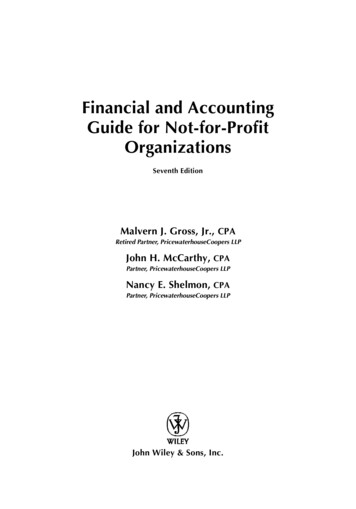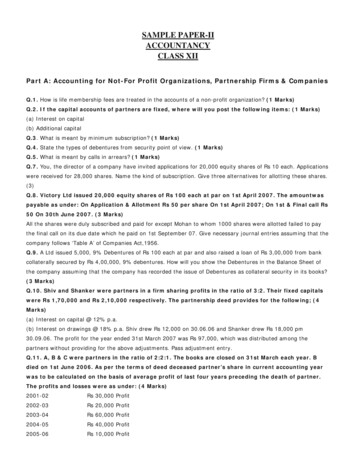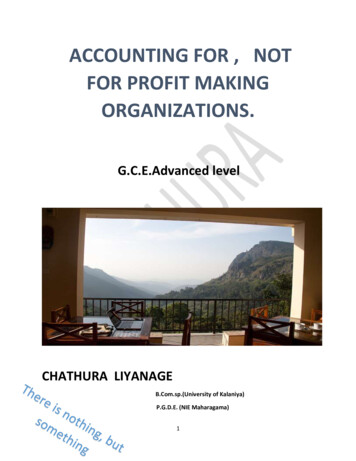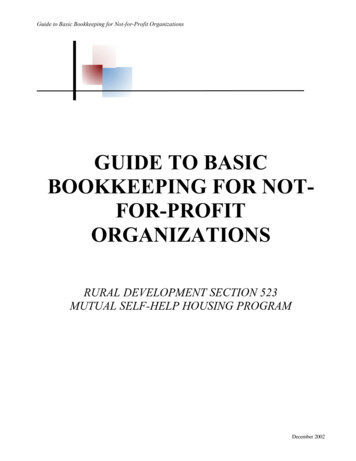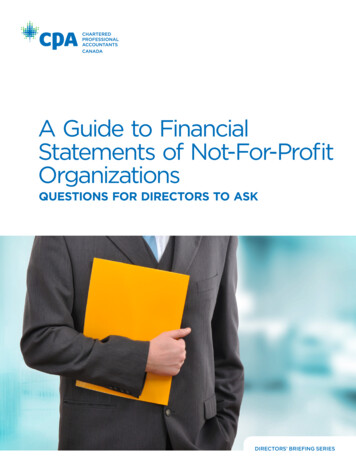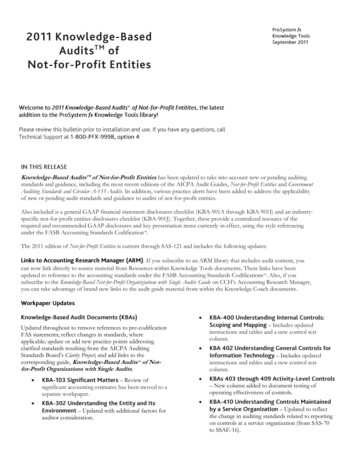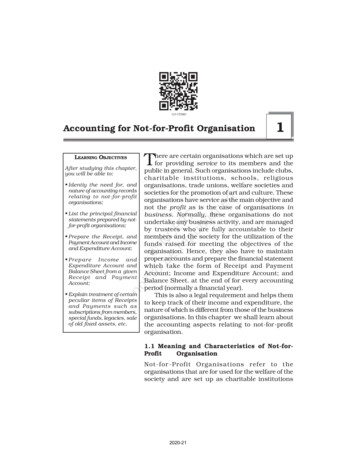
Transcription
Accounting for Not-for-Profit OrganisationLEARNING OBJECTIVESAfter studying this chapter,you will be able to; Identiy the need for, andnature of accounting recordsrelating to not-for-profitorganisations; List the principal financialstatements prepared by notfor-profit organisations; Prepare the Receipt, andPayment Account and Incomeand Expenditure Account; Prepare Income andExpenditure Account andBalance Sheet from a givenReceipt and PaymentAccount; Explain treatment of certainpeculiar items of Receiptsand Payments such assubscriptions from members,special funds, legacies, saleof old fixed assets, etc.1There are certain organisations which are set upfor providing service to its members and thepublic in general. Such organisations include clubs,charitable institutions, schools, religiousorganisations, trade unions, welfare societies andsocieties for the promotion of art and culture. Theseorganisations have service as the main objective andnot the profit as is the case of organisations inbusiness. Normally, these organisations do notundertake any business activity, and are managedby trustees who are fully accountable to theirmembers and the society for the utilization of thefunds raised for meeting the objectives of theorganisation. Hence, they also have to maintainproper accounts and prepare the financial statementwhich take the form of Receipt and PaymentAccount; Income and Expenditure Account; andBalance Sheet. at the end of for every accountingperiod (normally a financial year).This is also a legal requirement and helps themto keep track of their income and expenditure, thenature of which is different from those of the businessorganisations. In this chapter we shall learn aboutthe accounting aspects relating to not-for-profitorganisation.1.1 Meaning and Characteristics of Not-forProfitOrganisationNot-for -Profit Organisations r efer to theorganisations that are for used for the welfare of thesociety and are set up as charitable institutions2020-21
2Accountancy – Not-for-Profit Organisation and Partnership Accountswhich function without any profit motive. Their main aim is to provide service to aspecific group or the public at large. Normally, they do not manufacture, purchase orsell goods and may not have credit transactions. Hence they need not maintainmany books of account (as the trading concerns do) and Trading and Profit and LossAccount. The funds raised by such organisations are credited to capital fund orgeneral fund. The major sources of their income usually are subscriptions from theirmembers donations, grants-in-aid, income from investments, etc. The main objectiveof keeping records in such organisations is to meet the statutory requirement andhelp them in exercising control over utilisation of their funds. They also have to preparethe financial statements at the end of each accounting period (usually a financialyear) and ascertain their income and expenditure and the financial position, andsubmit them to the statutory authority called Registrar of Societies.The main characteristics of such organisations are:1. Such organisations are formed for providing service to a specific group orpublic at large such as education, health care, recreation, sports and so onwithout any consideration of caste, creed and colour. Its sole aim is to provideservice either free of cost or at nominal cost, and not to earn profit.2. These are organised as charitable trusts/societies and subscribers tosuch organisation are called members.3. Their affairs are usually managed by a managing/executive committeeelected by its members.4. The main sources of income of such organisations are: (i) subscriptionsfrom members, (ii) donations (general). (iii) legacies(general). (iv) grantin-aid, (v) income from investments, etc.5. The funds raised by such organisations through various sources arecredited to capital fund or general fund.6. The surplus generated in the form of excess of income over expenditureis not distributed amongst the members. It is simply added in thecapital fund.7. The Not-for-Profit Organisations earn their reputation on the basis oftheir contributions to the welfare of the society rather than on thecustomers’ or owners’ satisfaction.8. The accounting information provided by such organisations is meant forthe present and potential contributors and to meet the statutory requirement.1.2 Accounting Records of Not-for-Profit OrganisationsAs stated earlier, normally such organisations are not engaged in any trading orbusiness activities. The main sources of their income are subscriptions frommembers, donations, financial assistance from government and income frominvestments. Most of their transactions are in cash or through the bank. These2020-21
Accounting for Not-for-Profit Organisation3institutions are required by law to keep proper accounting records and keepproper control over the utilization of their funds. This is why they usually keepa cash book in which all receipts and payments are duly recorded. They alsomaintain a ledger containing the accounts of all incomes, expenses, assetsand liabilities which facilitates the preparation of financial statements at theend of the accounting period. In addition, they are required to maintain a stockregister to keep complete record of all fixed assets and the consumables.They do not maintain any capital account. Instead they maintain capitalfund which is also called general fund that goes on accumulating due tosurpluses generated, life membership fee, etc., received from year to year. Infact, a proper system of accounting is desirable to avoid or minimise the chancesof misappropriations or embezzlement of the funds contributed by the membersand other donors.Final Accounts or Financial Statements: The Not-for-Profit Organisations are alsorequired to prepare financial statements at the end of the each accounting period.Although these organisations are non-profit making entities and they are not requiredto make Trading and Profit & Loss Account but it is necessary to know whether theincome during the year was sufficient to meet the expenses or not. Not only thatthey have to provide the necessary financial information to members, donors, andcontributors and also to the Registrar of Societies. For this purpose, they have toprepare their final accounts at the end of the accounting period and the generalprinciples of accounting are fully applicable in their preparation as stated earlier,the final accounts of a ‘not-for-profit organisation’ consist of the following:(i) Receipt and Payment Account(ii) Income and Expenditure Account, and(iii) Balance Sheet.The Receipt and Payment Account is the summary of cash and banktransactions which helps in the preparation of Income and Expenditure Accountand the Balance Sheet. Besides, it is a legal requirement as the Receipts andPayments Account has also to be submitted to the Registrar of Societies alongwith the Income and Expenditure Account, and the Balance Sheet.Income and Expenditure Account is akin to Profit and Loss Account. TheNot-for-Profit Organisations usually prepare the Income and ExpenditureAccount and a Balance Sheet with the help of Receipt and Payment Account.However, this does not imply that they do not make a trial balance. In order tocheck the accuracy of the ledger accounts, they also prepare a trial balancewhich facilitates the preparation of accurate Receipt and Payment Account aswell as the Income and Expenditure Account and the Balance Sheet.In fact, if an organisation has followed the double entry system they mustprepare a trial balance for checking the accuracy of the ledger accounts and itwill also facilitate the preparation of Receipt and Payment account. Incomeand Expenditure Account and the Balance Sheet.2020-21
4Accountancy – Not-for-Profit Organisation and Partnership Accounts1.3 Receipt and Payment AccountIt is prepared at the end of the accounting year on the basis of cash receipts andcash payments recorded in the cash book. It is a summary of cash and banktransactions under various heads. For example, subscriptions received from themembers on different dates which appear on the debit side of the cash book, shallbe shown on the receipts side of the Receipt and Payment Account as one itemwith its total amount. Similarly, salary, rent, electricity charges paid from time totime as recorded on the credit side of the cash book but the total salary paid, totalrent paid, total electricity charges paid during the year appear on the paymentside of the Receipt and Payment Account. Thus, Receipt and Payment Accountgives summarised picture of various receipts and payments, irrespective of whetherthey pertain to the current period, previous period or succeeding period or whetherthey are of capital or revenue nature. It may be noted that this account does notshow any non cash item like depreciation. The opening balance in Receipt andPayment Account represents cash in hand/cash at bank which is shown on itsreceipts side and the closing balance of this account represents cash in hand andbank balance as at the end of the year, which appear on the credit side of theReceipt and Payment Account. However, if it is bank overdraft at the end it shallbe shown on its debit side as the last item. Let us look at the cash book of GoldenCricket Club given in the example to show how the total amount of each item ofreceipt and payment has been worked out.Example 1Golden Cricket ClubCash Book (Columnar)Dr.DateReceipts2014April 1 Balance b/dApril 10 SubscriptionsApril 10 Entrance feesMay 20 Life membershipfeesJune 12 Locker rentJuly 23 Life membershipfeesAug. 20 Donation forbuildingSept. 13 Subscriptions(2013-14)Sept. 13 SubscriptionL.F.BankOffice DateAmount Amount(Rs.)(Rs.) 2014Payments201435,000 20,000 April 15 Insurance premium1,20,000May 12 Printing andstationery13,000May 20 Postage and12,000courier feesJune 16 Telephone42,000expenses8,000July 10 Wages and salariesJuly 15 Rates and Taxes60,000July 30 Govt. securitiesAug. 13 Printing and30,000stationeryAug. 15 Postage and45,000courier serviceSept. 10 Lighting2020-21Cr.L.F.BankOfficeAmount ,00015,00048012,250
Accounting for Not-for-Profit OrganisationSept. 14 Entrance feesNov. 9 Subscription10,00035,000Nov. rest ongovernmentsecurities18,0002015Feb. 07Mar. 285Sept 13 Telephone expensesOct. 1 Wages and salariesOct. 18 Printing andstationeryOct. 31 Govt. securitiesDec. 31 Wages and Salaries2015Jan. 21 Courier chargesFeb. 2 TelephoneexpensesMar. 10 Postage andCourier feesMar. 27 LightingMar. 27 Wages and SalariesMar. 31 Balance c/d4,21,000 62,000Item wise Aggregation of various ReceiptsSubscriptions (2014–2015)Amount (Rs.)April 10, 2014Sept. 13, 2014Nov. 9, 2014Feb. 7, ptions (2013–14)DateAmount (Rs.)Sept. 13, 201430,000Total30,000Subscription (2015–16)DateAmount (Rs)Nov. 9, 201410,000Total10,000Entrance FeesDate1,00,00022,00024096085014,00022,00070,000 23,4004,21,000 62,000Part ADate83010,000 12,00013,000Amount (Rs)April 10, 2014Sept.14, 201413,00010,000Total23,0002020-21
6Accountancy – Not-for-Profit Organisation and Partnership AccountsLocker RentDateAmount (Rs)June 12, 201442,000Total42,000Life Membership feeDateAmount (Rs)May 20, 2014July 23, 201412,0008,000Total20,000Donation for BuildingsDateAmount (Rs)Aug. 20, 201460,000Total60,000Interest on Government securitiesDateAmount (Rs)March 28, 201518,000Total18,000Part BItem wise Aggregation of various PaymentsInsurance PremiumDateAmount (Rs)April 15, 201415,000Total15,000Printing and StationeryDateAmount (Rs.)May 12, 2014Aug. 13, 2014Oct. 18, 201410,75015,00013,000Total38,750DateAmount (Rs.)LightingSept. 10, 2014March 27, 201512,25014,000Total26,2502020-21
Accounting for Not-for-Profit Organisation7Telephone ExpensesDateAmount (Rs.)June 16, 2014810Sept. 13, 2014830Feb. 2, 2015960Total2,600Rates and TaxesDateAmount (Rs.)July 15, 201417,000Total17,000Government SecuritiesDateAmount (Rs.)July 30, 20141,00,000Oct. 31, 20141,00,000Total2,00,000Wages and SalariesDateAmount (Rs.)July 10, 201422,000Oct. 1, 201422,000Dec. 31, 201422,000March 27, 201522,000Total88,000Postage and Courier ServiceDateAmount (Rs.)May 20, 2014430Aug. 15, 2014480Jan. 21, 2015240March 10, 2015850Total2,000The above data can also be shown in the form of the respective accounts inthe ledger. A detailed illustrative list of items of receipts and payments is givenin figure 1.2020-21
8Accountancy – Not-for-Profit Organisation and Partnership AccountsFigure 1ReceiptsPayments1. Donations(a) General(b) Specific purpose2. Entrance Fees3. Legacies4. Sale of Investments5. Sale of Fixed Assets6. Subscriptions from Members7. Life Membership Fees8. Sale of old Newspapers9. Sale of Old Sports Material10. Interest on Fixed Deposits11. Interest/ Dividend on Investments12. Proceed from Charity Shows13. Sale of Scrap14. Grant-in-aid15. Interest/Dividend on SpecificFund Investments16. Miscellaneous .18.19.Purchase of Fixed AssetsPurchase of Sports MaterialInvestment in SecuritiesPrinting and StationeryPostage and Courier ChargesAdvertisementsWages and SalaryHonorariumTelephone ChargesElectricity and Water ChargesRepairs and RenewalsUpkeep of Play GroundConveyance ChargesSubscription for PeriodicalsAudit FeesEntertainment ExpensesMunicipal TaxesCharityInsuranceReceipt and Payment Account is given below:Receipt and Payment Account for the year ending ————ReceiptsBalance b/dCash in HandCash at BankSubscriptionsGeneral DonationsSale of newspaper/periodicals/waste paperSale of old sports materialsInterest on fixed depositsInterest/Dividend on generalinvestmentsLocker RentSale of scrapsProceeds from charity showMiscellaneous receiptsGrant-in-aidLegaciesSpecific DonationsSale of InvestmentsSale of Fixed xxxxxxxxxxxxxxxPaymentsBalance b
Accounting for Not-for-Profit Organisation 3 institutions are required by law to keep proper accounting records and keep proper control over the utilization of their funds. This is why they usually keep a cash book in which all receipts and payments are duly recorded. They also maintain a ledger containing the accounts of all incomes, expenses, assets and liabilities which facilitates the .
